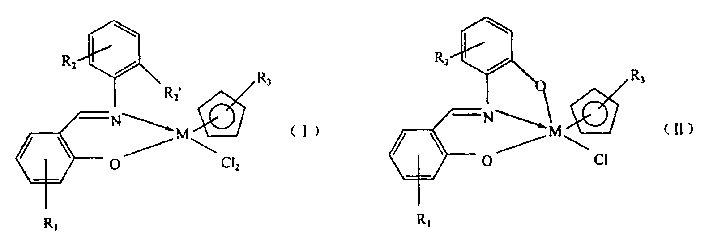Catalyst containing mono schiff base ligand and its preparation and usage for olefine polymerization
A technology of olefin polymerization and Schiff base, which is applied in the field of olefin polymerization catalysts and its preparation, and can solve the problems of polymer molecular weight decrease and difficulty in obtaining polyethylene
- Summary
- Abstract
- Description
- Claims
- Application Information
AI Technical Summary
Problems solved by technology
Method used
Image
Examples
preparation example Construction
[0015] Catalyst preparation method provided by the invention, comprises the steps:
[0016] (1) react the Schiff base ligand compound shown in formula (III) with the alkyl alkali metal compound in an organic medium in an equimolar ratio to generate the alkali metal salt of the Schiff base complex, R in the formula (III) 1 selected from hydrogen, C 1 ~C 12 Alkyl, C 1 ~C 12 Alkoxy or C 6 ~C 12 Aryl, R 2 selected from hydrogen or C 1 ~C 4 the alkyl group, R 2 "Selected from hydrogen, C 1 ~C 4 Alkyl or C 1 ~C 4 alkoxy,
[0017] (2) the alkali metal salt of the Schiff base complex is expressed as CpMCl in an organic medium 3 The cyclopentadienyl metal chloride is reacted in an equimolar ratio, the solvent is removed, the residue is washed with an organic solvent, filtered, and the filtrate is recrystallized; the CpMCl 3 M is Ti, Zr or Hf, Cp is a monosubstituted cyclopentadienyl, and the substituent R 3 selected from hydrogen, C 1 ~C 12 Alkyl, C 1 ~C 12 Alkoxy...
example 1
[0029] Preparation of (salicylidene 2,6-diisopropylaniline)-(methylcyclopentadienyl)titanium dichloride.
[0030] (1) Preparation of ligand compound salicylidene 2,6-diisopropylaniline
[0031] In a 250ml three-neck flask, add 12.2g (0.1mol) salicylaldehyde (China Pharmaceutical (Group) Shanghai Chemical Reagent Company), and add 100ml ethanol, heat to reflux temperature, drop 30ml to dissolve 17.7g (0.1 mol) 2,6-diisopropylaniline (Shanghai Reagent No. 1 Factory, China) solution, reflux reaction for 2 hours. After cooling to room temperature, a large amount of solid precipitated out. Filter and recrystallize the solid with 30ml of ethanol to obtain 26g of yellow-green crystals, which is salicylidene 2,6-diisopropylaniline (C 19 h 23 ON), yield 92%.
[0032] (2) Preparation of catalyst
[0033] Add 1.65g (5.95mmol) of salicylidene 2,6-diisopropylaniline and 30ml of tetrahydrofuran into a 100ml Schlenk bottle, cool the solution to -70°C, and add 2.96ml (2.0113mol L -1 , 5...
example 2
[0042] Preparation of (salicylidene-oanilino)-(cyclopentadienyl)titanium chloride.
[0043] (1) Prepared according to the method of Example 1, the difference is that 12.3g (0.1mol) o-methoxyaniline (manufacturer China Shanghai Reagent No. 1 Factory) is used instead of 2,6-diisopropylaniline for reaction, and finally the ligand is obtained Salicylidene o-methoxyaniline 20g, yield 88%.
[0044] (2) Preparation of catalyst
[0045] Add 1.745g (7.68mmol) salicylidene o-methoxyaniline and 30ml toluene to a 100ml Schlenk bottle, cool the solution to -70°C, and add 3.82ml (2.0113mol L -1 , 7.68mmol) butyllithium, after the dropwise addition, bright yellow turbidity appeared, which was naturally raised to room temperature and stirred for 3 hours to obtain a toluene solution of salicylidene o-methoxyaniline lithium salt.
[0046] The above lithium salt solution was cooled to -70°C, and 1.684 g (7.68 mmol) of cyclopentadienyl titanium trichloride (CpTiCl) was rapidly added dropwise. ...
PUM
| Property | Measurement | Unit |
|---|---|---|
| IR spectroscopy | aaaaa | aaaaa |
Abstract
Description
Claims
Application Information
 Login to View More
Login to View More - R&D
- Intellectual Property
- Life Sciences
- Materials
- Tech Scout
- Unparalleled Data Quality
- Higher Quality Content
- 60% Fewer Hallucinations
Browse by: Latest US Patents, China's latest patents, Technical Efficacy Thesaurus, Application Domain, Technology Topic, Popular Technical Reports.
© 2025 PatSnap. All rights reserved.Legal|Privacy policy|Modern Slavery Act Transparency Statement|Sitemap|About US| Contact US: help@patsnap.com

